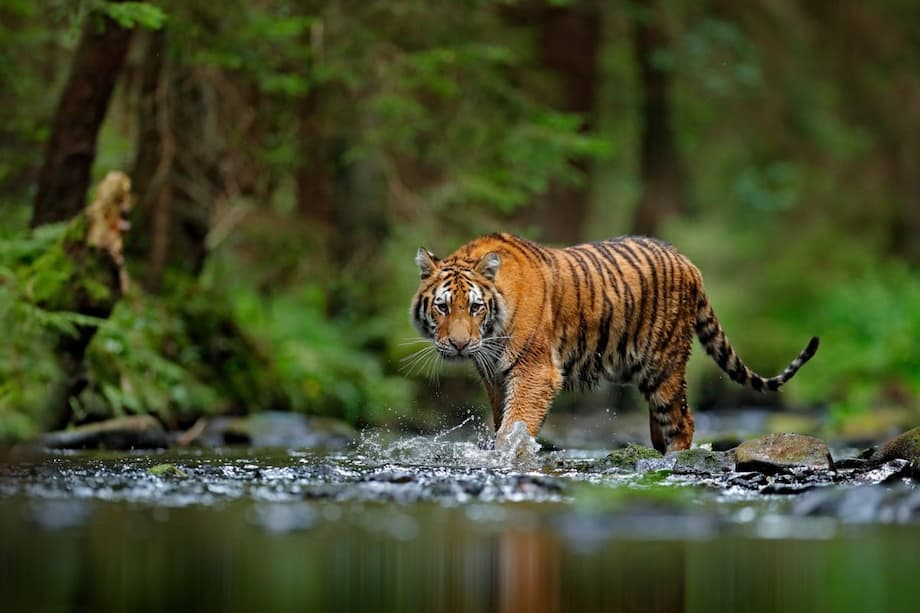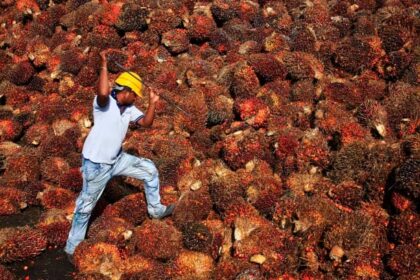A silent forest and a warning from new research
From tigers and leopards to bears, otters and deer, the forests of North Korea are growing quiet. A peer reviewed study in Biological Conservation warns that the country is experiencing rapid defaunation, the draining of wildlife from landscapes, driven by hunger, a thriving black market and exploitation tied to state interests. Researchers say almost every large mammal is being hunted for meat, fur or parts, and some species that once defined the Korean Peninsula are now gone from the North.
The research team, led by scientists working with University College London and partners in Europe, compiled the first baseline picture of contemporary wildlife use inside the isolated state. Their interviews suggest that the sable, a small carnivore long prized for dense fur, has become functionally extinct in North Korea. They also warn that endangered Amur tigers and leopards that disperse from northeast China and Russia face high risk if they cross the border, undermining hard won recoveries in those countries.
The picture that emerges extends beyond poachers and buyers. Economic collapse in the 1990s pushed citizens to hunt to survive, informal markets grew into durable trading networks, and state bodies have been reported to profit from wildlife products. North Korea is not a party to the Convention on International Trade in Endangered Species of Wild Fauna and Flora, and researchers warn that cross border sales into China include protected species, raising concerns about compliance with CITES and United Nations Security Council resolutions.
What the study found and how it was done
Working inside the country is close to impossible for independent scientists. To overcome that barrier, the team conducted structured interviews with 42 North Korean defectors in 2021 and 2022, including former soldiers, hunters, traders and consumers. This local ecological knowledge approach is widely used when access, safety or transparency is limited. While it cannot replace a full wildlife census, it yields detailed accounts of what people saw, bought and sold during periods of scarcity and in the years since.
Respondents described harvesting of almost all native mammal species weighing more than half a kilogram. Wildlife used as a state economic resource was said to include animals protected under North Korean law. Many interviewees traced the surge in hunting and trade to the famine of the late 1990s, after the public distribution system collapsed. Informal markets widened, and wildlife became both a safety net for households and a commodity for traders who supplied domestic buyers and buyers across the border.
Joshua Elves-Powell, an associate lecturer in biodiversity conservation and ecology at University College London and a co author of the study, said the trend amounts to a dramatic emptying of forests. He warned that the loss will touch communities inside North Korea and also spill across borders to neighboring ecosystems.
“There is a strong risk of defaunation of North Korea’s forests, a scenario where they are effectively emptied.”
He also described the breadth of hunting pressure recorded in the interviews.
“Almost every mammal species in North Korea larger than a hedgehog is opportunistically captured for consumptive use or trade.”
The study was published in the journal Biological Conservation and argues that continued exploitation could sever wildlife movement between the Korean Peninsula and mainland Asia, harming recoveries in China and Russia.
Survival, markets and the state
Interviewees linked the boom in hunting to survival during the famine years. Millions faced deprivation after the state distribution system failed, and families turned to forests, rivers and coasts for food and income. Informal markets, known locally as jangmadang, became the backbone of daily life. The skills, contacts and routes established in that period have since matured into trade networks that move animal parts internally and into China.
Multiple defectors described state involvement. Local authorities collected animal skins and other products as tribute. Households were told to meet quotas, and children were tasked with raising rabbits for their pelts. Reports cited government run farms that kept bears for bile extraction and bred deer, otters and pheasants for parts and skins. State institutions were also said to have supplied wildlife products that reached buyers outside the country.
North Korea has laws and a formal system of protected areas, but interviewees portrayed frequent breaches by both citizens and officials. The country is not a signatory to CITES, the treaty that regulates international trade in endangered species. Researchers warn that some cross border sales to China involve protected species, which can conflict with China’s obligations under CITES and United Nations Security Council resolutions. They urge compliance on both sides of the frontier.
Species under greatest pressure
The accounts collected by researchers read like an inventory of the peninsula’s natural heritage. Interviewees listed tigers, leopards, bears, deer and otters. They also named the long tailed goral, wild boar, red fox and smaller carnivores such as badger and weasel. Hunting was for meat, skins and bones, and for parts used in traditional medicine, including deer antlers and bear bile.
Sable, a vanished icon
Once common on the peninsula, the sable was prized for its dense, glossy fur. Traders and hunters told researchers that the animal has disappeared from the North. The study concludes the species is functionally extinct there, meaning any remaining individuals are too few to play their ecological role. Sable are small forest carnivores that prey on rodents and birds and help keep food webs balanced.
Defectors recalled how sable skins that were once a routine sight in markets became rare, then vanished. This decline mirrors reports from other parts of East Asia where intensive trapping for fur emptied forests of furbearers within a few decades.
Tigers and leopards at the border
A small but growing population of Amur tigers and Amur leopards has been documented in northeast China and the Russian Far East. Conservation over the past decade created space for animals to disperse toward the Changbai mountains and the Tumen River region that abuts North Korea. Researchers warn that cats crossing into North Korean territory face high risk of being killed for skin, bones and other parts valued in regional markets.
Any losses on the North Korean side would weaken fragile recoveries across the border. Large predators range over great distances and need connected habitat with prey such as deer and boar. If the peninsula acts as a dead end for dispersing animals, the wider metapopulation can suffer. This concern applies to other wide ranging species as well.
Bears, deer and otters in demand
Interviewees described the use of Asiatic black bears for bile extraction and the sale of paws and organs. Deer were valued as high status food, and antlers and organs fed a long running trade for traditional remedies. Otters were sought for their pelts. The long tailed goral, a cliff dwelling goat antelope classed as vulnerable, was hunted for meat. Some accounts also mentioned the trapping of badgers for oil, the sale of fox and weasel skins and the wide use of snares in forests near villages.
Respondents reported that farms kept by state bodies raised bears, deer and otters to meet demand. There were also reports of coypu, an introduced rodent farmed for fur, spreading through wetlands as an invasive species. That combination of wild harvest and captive breeding keeps parts flowing into markets and can mask the origin of products once they pass into traders’ hands.
Why losing apex predators matters
Ecologists use the term keystone species to describe organisms that hold ecosystems together. Apex predators often play that role by limiting prey numbers and allowing plants and smaller animals to flourish. When top predators are removed, herbivores can overgraze forests and grasslands, smaller predators can explode in number and entire landscapes can shift in ways that reduce biodiversity and harm people who rely on natural resources.
The concept is well known from studies of wolves in North America and sea stars on Pacific shores. It applies in East Asia as well. If tigers and leopards vanish from one side of a transboundary landscape, deer and boar numbers can surge, crop damage can rise, and forests can lose seedlings. Over time, the loss of predators and mid sized carnivores like sable can loosen the threads that make these ecosystems resilient to fire, disease and climate stress.
Defaunation, the systematic loss of wildlife from habitats, is a tragedy for large charismatic animals. It also removes pollinators, seed dispersers and nutrient carriers. Once forests are emptied of these roles, recovery can take decades even if protection improves later.
Law, sanctions and regional responsibility
North Korea maintains lists of protected species and maps protected areas. Interviewees said those protections are often ignored, with hunting and trapping carried out for personal use, for local markets and for the state. The country is outside CITES, the global treaty that restricts the trade in threatened wildlife. That absence makes border controls and cooperation with neighbors even more critical.
China is a major destination for wildlife products from the Korean Peninsula. Researchers warn that some trade from North Korea may breach China’s commitments under CITES and United Nations Security Council resolutions. Effective enforcement requires coordinated action by customs, border police and market inspectors, as well as demand reduction so buyers stop seeking parts like tiger bone, bear bile and deer antler.
Public reporting on seizures and prosecutions related to cross border wildlife trade is limited in this geography. Transparency, data sharing and joint patrols could help. Better tools also exist. DNA analysis, isotope testing and digital tracking can reveal the origin of wildlife parts, making it harder to launder illegal products through farms or false labeling.
What can help now
The researchers recommend that North Korea enforce its own laws and end state backed exploitation through farms and collection quotas. They also call on China and other neighbors to pressure supply chains and buyers who profit from North Korean wildlife. Reducing the incentive to poach will require both stronger law enforcement and replacement livelihoods for people who depend on forests and rivers to get by.
Humanitarian measures matter for conservation in this context. Where communities have reliable food and income, hunting pressure falls. Programs that pay residents to monitor wildlife or remove snares can work if they are trusted and funded. Support for domestic livestock, improved fish farming and alternative medicines can lower demand for wild meat and animal parts. Education campaigns in consumer markets can reduce the social status linked to owning tiger bone or bear bile products.
Biologists also see an opportunity in connectivity. The Korean Peninsula sits between continental East Asia and island rich seas to the south. Protecting corridors that link China, Russia and the peninsula would help ensure that tigers, leopards and other wide ranging species can move safely. South Korea’s Demilitarized Zone and adjacent Civilian Control Zone, which hold thousands of species documented by the National Institute of Ecology, demonstrate how wildlife rebounds when human intrusion is limited. A lasting safeguard inside North Korea would require areas with real protection from hunting and trade.
Science under constraints
The study relies on testimony from defectors rather than on camera traps and field surveys. That approach carries uncertainty about locations and exact numbers. The richness of detail across dozens of interviews, combined with similar reports from regional markets, makes the overall picture hard to dismiss. It establishes a baseline of use and trade that future work can test.
Practical steps exist even with limited access. Camera traps and acoustic sensors can be placed near borders to record rare species. Satellite images can reveal logging tracks, woodland clearing and fire scars. Forensic analysis in markets can trace products back to North Korea. Regional scientists already collaborate on tiger and leopard monitoring, and those networks could expand to include more data from the peninsula.
The Essentials
- Peer reviewed research indicates rapid defaunation of North Korean forests driven by hunger, black markets and state involvement.
- Interviews with 42 defectors describe harvesting of almost all native mammals heavier than half a kilogram.
- Sable is believed functionally extinct in North Korea, and cross border risk threatens Amur tigers and leopards.
- State bodies were reported to collect wildlife products and run farms for bears, deer, otters and pheasants.
- North Korea is not a party to CITES, and some trade into China may breach international obligations.
- Products include meat, skins, and parts used in traditional medicine, such as deer antlers and bear bile.
- Researchers urge domestic enforcement, a halt to state backed exploitation and stronger action by China to curb demand.
- Loss of apex predators and mid sized carnivores risks cascading ecological change and harm to neighboring ecosystems.
- Digital forensics, border monitoring and transparent data sharing could disrupt illegal trade networks.
- Conservation success depends on both protection and improved livelihoods that reduce reliance on wild harvest.












